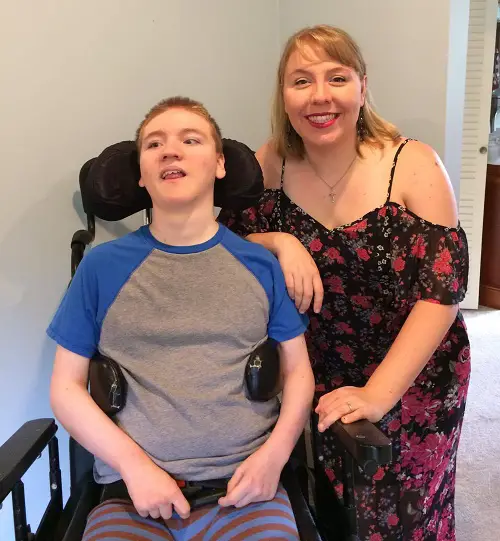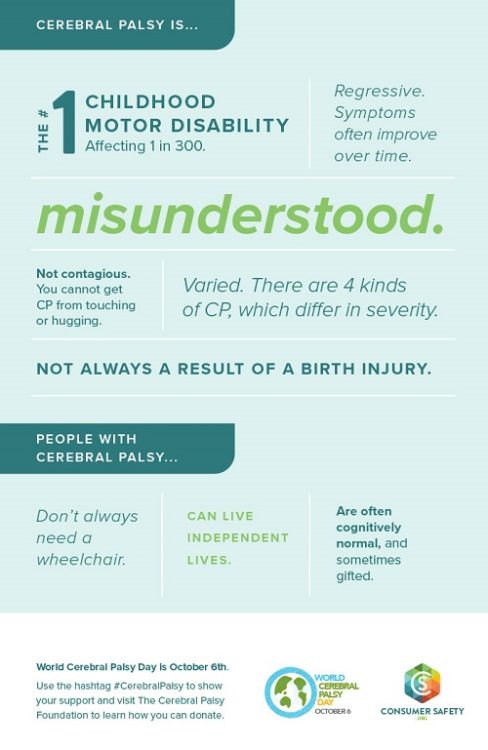
World Cerebral Palsy Day: changing misconceptions about CP
Tomorrow, 6th October, is World Cerebral Palsy Day. So, to mark the day and to change people’s perceptions, Lindsey Pasieka, whose brother has cerebral palsy, busts 10 common misconceptions about the disability.
One thing people often assume is that all people with cerebral palsy (CP) are the same. But far from it – they’re all unique, with their own strengths and weakness, just like anyone else.
This is certainly true of my brother, Derek, who has CP. Derek’s CP is severe, and comes with a litany of other diagnoses, including epilepsy and profound mental disabilities. Growing up and watching him struggle was more than a little difficult. But, for me, learning more about CP and hearing from families like (and unlike!) ours, has helped me feel less alone. It has lifted a weight off me that I didn’t know was there.

1. People with cerebral palsy are not always mentally impaired.
Not only are a lot of people with CP fully-functional mentally, but some of them are intellectually gifted. Many people with CP have graduated from college, received doctorate degrees, and work in a huge variety of industries.
When you assume someone has a lack of mental capacity, your presumption can have a profound effect on them.
This can lead to condescension in schools by teachers and bullying by peers. Regardless of a person’s mental capabilities, we all deserve respect. But when you judge a person’s intellect based on a physical impairment, especially a child, you are contributing to a culture of ‘lesser than’, which makes these wonderful people feel belittled.
2. People with cerebral palsy don’t always need a wheelchair.
Some people with CP require a wheelchair. My own brother does, and he looks darn spiffy in it. But that’s not always the case. Just like some people with CP may have fully-functioning mental faculties, others may have little to no walking impairment. Many people with CP are actually able to walk with the assistance of crutches, specially built for enhanced support. Others can move without any assistance.
3. People with cerebral palsy can often communicate fully.
Some people with CP do have impairments related to hearing and speech. Depending on the cause of CP, there are higher risks for hearing and speech development, and consequently, there can be communication challenges. Again, some of this may also be based on a child’s cognitive development. If CP is paired with mental problems, it will, of course, have an impact.
However, not all kids will lose their hearing or speech.
Even those with hearing impairments often use sign language or communication boards to make their voices heard. If a child doesn’t speak, you should, again, never assume they have a mental impairment. It’s just as rude as talking slowly to a deaf person.
Lack of hearing or speaking does not equal lack of thought.
4. Cerebral palsy is NOT contagious.
There are multiple causes for CP. They can be because of:
- hereditary issues that result in the symptoms;
- non-genetic errors that occur during pregnancy;
- traumatic injury during or soon after birth.
None of these causes mean CP is contagious. You cannot get CP from touching or hugging a person with CP, and babies cannot get it from contact with their mothers if they have CP.
So often people shy away from people with CP as if they have leprosy. It’s painful for both them and their families. It’s an awful form of ostracisation that the person with CP can do very little about. Contact is important for all people – it’s one of the best ways we know to connect.
5. All cerebral palsy is NOT the same.
Actually, there are four kinds of CP:
- spastic cerebral palsy;
- dyskinetic cerebral palsy
- ataxic cerebral palsy;
- mixed cerebral palsy.
Within each type, there is a huge spectrum of severity, and each person will have a different cerebral palsy experience.
CP is often a diagnosis of exclusion. This means that if your symptoms fall into the categories, and other causes have been ruled out, you may be diagnosed with CP. This is similar to how many people are diagnosed with Fibromyalgia.
So in essence, it covers a HUGE range of abilities and needs. For some, it may be the only diagnosis they have, while for others, it comes along with a laundry list of other complications. In getting to know people with CP, I’ve learned that no two stories are the same.

6. Many people with cerebral palsy live independently.
I probably sound like a broken record, but CP is so varied and so common, none of these assumptions apply to everyone with the condition. Some people with CP may need lifelong assistance. They might require nurses, or a guide dog, or even care in a facility as an adult.
At the same time, many other with CP live completely independent lives. They drive cars, maybe even specially-built ones. They have their own homes, jobs, pay rent, have pets, relationships, cook, or go out for dinner. The point is, for many people, their CP does not limit their ability to live and enjoy life on their own.
7. People with cerebral palsy can have children.
Cerebral palsy does not usually affect fertility. Now, some people with CP may choose adoption due to medical issues. This would especially apply to people where CP is just one of several conditions, such as heart defects. In addition, some women with CP may be more likely to have a high-risk pregnancy due to a multitude of reasons.
However, many people with CP choose to and quite successfully have children biologically.
A person who has CP will NOT necessarily pass it on to their child.
So many people with CP have kids without any medical conditions at all!
8. Cerebral palsy is actually common
Because its definition is broad, CP is actually the number one childhood motor disability and can affect as many as 1 in 323 children. Again, when people think of CP, they think of the ‘worst case scenario’. The non-verbal, non-cognitive kid in the wheelchair who will always need help with everything. If you think this way, you’re only acknowledging a small number of people with CP.
9. Cerebral palsy is progressive.
Usually, CP does not have degenerative effects. However, over time, it can worsen, usually by tightening muscles. To counteract this, people with CP use tools, such as physical therapy, especially during the childhood years, to reinforce and grow muscle that has naturally low tone. As a result, often the symptoms get better over time.
10. Cerebral palsy is always the result of a birth injury.
I talked about this before. CP can be caused by trauma to the brain before, during, or soon after birth. However, it can also be caused by factors like inflammation, congenital disorders, infections during pregnancy or maternal health issues.
This preconception often makes doctors look like ‘the bad guy’ when there are other underlying issues. For example, my brother has CP, but my mother’s pregnancy was completely normal. The doctors were professional and helpful, delivery was normal, and we didn’t even know something was wrong until he started missing developmental milestones.
Did you catch the overarching theme here?
Assumptions are the enemy of connections, of learning and of compassion.
If you meet a person with, approach them with openness and kindness. If they want to tell you their story, listen, learn, ask questions politely, and let them show you their world. Don’t shut yourself off based on preconceived notions which are so often wrong. And above all, remember that EVERYONE deserves respect.
By Lindsey Pasieka
For more advice and information on cerebral palsy, visit Consumer Safety and Scope. You can find out more about World Cerebral Palsy Day by visiting its website.
Get in touch by messaging us on Facebook, tweeting us @DHorizons, emailing us at editor@disabilityhorizons.com or leaving your comments below.
https://disabilityhorizonscom.onyx-sites.io/2017/04/cerebral-palsy-life-as-a-disabled-student/
https://disabilityhorizonscom.onyx-sites.io/2014/09/greatest-love-story-sport-cerebral-palsy/